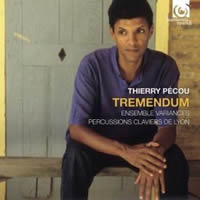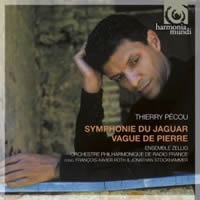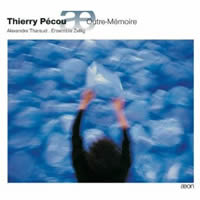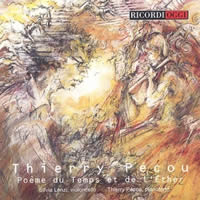Thierry Pécou
|
Grant Chu Covell [December 2012.]
Thierry PÉCOU: Tremendum (2005-2010); Soleil-Tigre (2009); Manoa (2005); L’Arbre aux fleurs (2010); Danzón (1998). Guillermo DIEGO / Thierry PÉCOU: Paseo de la Reforma (1995-2010). Ensemble Variances: Thierry Pécou (pno), Anne Cartel (fl), Carjez Gerretsen (bclar), Nicolas Prost (sax), David Louwerse (vlc); Percussions Claviers de Lyon: Raphaël Aggery, Sylvie Aubelle, Jérémy Daillet, Gilles Dumoulin, Gérard Lecointe. Harmonia Mundi HMC 905269 (1 CD) (http://www.harmoniamundi.com/). Thierry PÉCOU: Symphonie du Jaguar (2002)*; Vague de pierre (2007). Ensemble Zellig: Étienne Lamaison* (clars), Laurent Cabaret* (trb), Marc Vieillefon* (vln), Silvia Lenzi* (vlc), Caterine Dune* (sop), Séverine Etienne-Maquaire*, Florence Barreau-Zuretti*, Irina de Baghy*, Andrea Hill* (m sop); Orchestre Philharmonique de Radio France, François-Xavier Roth*, Jonathan Stockhammer (conds). Harmonia Mundi HMC 905267 (1 CD) (http://www.harmoniamundi.com/). Let there be no doubt that Pécou is a modernist. However casual a listen reveals special touches, something completely unexpected, perhaps a new instrument, a pause or a gesture, all unpredictable, that make clear Pécou’s different vantage point. Contemporary music is rife with composers rooted in European traditions who peer out sometimes yearningly. Like Messiaen and Vivier, Pécou employs Western instruments and structures yet reflects other music. This Parisian with Caribbean ancestry (b. 1965) also perpetuates the crystal palette of Ravel, Dutilleux and Boulez in orchestral and chamber works. Harmonia Mundi has enriched Thierry Pécou’s discography with three releases. The first features Alexandre Tharaud at the piano. The latest includes Tremendum, a bewitching concerto appropriately subtitled “Concerto-carnival” for an imaginative Brazilian fresco. Scored for piano, flute, saxophone, cello and five percussionists, the work slithers through genres hinting at European, Amerindian and African influences. Easy jazz punctures a tribal riff which overrides an invented recollection that might have been Milhaud’s. Tremendum could be heard as a response to Gershwin’s American in Paris, a European exploring South America, along with undercurrent in Pécou’s narrative. We need to remember that some cultures see nothing wrong with destroying another in the name of civilization. Look and be changed, but do not touch. Tremendum is followed by the tightly wound Soleil-Tigre for cello and piano. Pécou offers angular bursts rather than catchy tunes. A flowing phrase may appear merely to help get from one place to another. Manoa for bass flute, bass clarinet and cello utilizes ostinatos and suggests Pécou admires Reich. L’Arbre aux fleurs offers two colorful movements for five mallet percussions (there are also drums, and at the seven-minute mark in Perles de jade, I hear a pattern Xenakis employed for Pleiades). Danzón is for solo flute and Paseo de la Reforma is a bright arrangement resembling Torke. Pécou, himself a capable player, appears to sidestep overt expression. Two symphonies occupy HMC 905267, though only one is explicitly labeled. Symphonie du Jaguar concerns Mayan civilization, whereas Vague de pierre visits the classic poetry and painting of China. The four-part trip to Mesoamerica requires solo clarinet, trombone, violin, cello and five female voices plus orchestra. The whimsically lurching music achieves climaxes and tranquil dissolves. We hear intimate moments such as the delicate opening with the skittering soloists, and gigantic percussive onslaughts. Appearing in all but the third movement, the women’s voices alternate between an otherworldly unison and a rambunctious crowd. Pécou perhaps drew inspiration from old Swingle Singers records, Les Noces, or recent Aperghis. Scelsi’s Uaxuctum and just about any Revueltas come to mind as well. That said, Pécou holds to his French heritage: At 3:51 into Jaguar’s second movement, Très modéré, I swear the descending brass take a cue from Turangalîla. Where Jaguar’s movements dealt with nature, stars and the underworld, Vague de pierre is less specifically illustrative. We’re to listen to this symphony as one might contemplate a precious landscape, with its cavernous shapes and abstract non-thematic motions. Harmonies pass in and out of view. High-pitched chords suggest Sibelius’ Cranes. After two languid movements, the third’s speed surprises. The progress is sure, yet unpredictable: The fourth movement hides a mighty caesura before the music continues, ending uncertainly with held chords.
While it may be premature to talk of masterpieces, a 2004 Aeon (AECD 0423) release is given over to what might be one of Pécou’s best achievements, Outre-Mémoire (2003). This gigantic, hour-long quartet for piano (Alexandre Tharaud), flute (Anne-Cécile Cuniot), clarinet (Étienne Lamaison) and cello (Silvia Lenzi) confronts the slave trade. Pécou is not searching for pity or hand-holding. Don’t look for dance tunes or ethnomusical dioramas. The 12 movements contain interleaved sub-series: four Traces-mémoires — effacement, four Mambú and three Mulonga, dialogue gestuel, etc. Despite the titles, the music is hard to place. Somber Messiaen might describe it, yet there’s that edge we hear in Shostakovich. Occasional patterning calls to mind a dissonant Reich. Close listening suggests that the players must move around the venue for spatial effects. There are also percussive sounds (chimes), rustling paper (or maybe plastic) and dripping water. It’s unclear whether these are electronically derived or sculptural components within the performance space. A 1997 BMG Ricordi release (74321 405892) circles around chamber music for cello (Silvia Lenzi) and piano (the composer). While these pieces may not approach nearly the same vibrancy as recent works, Harmonia Mundi’s programs prime the ear for the unexpected. Indeed in the cello-piano duo Poème du temps et de l’éther (1994) an alto flute passes through much like the visiting elements in Ives’ Concord Sonata. The piano writing reveals Pécou’s interest in detached gestures and repetitions of curious shards. Nocturne IV (1989) suggests a nervous and intense Sciarrino. One of the Cinq Pièces Brèves (1990-93) is a sparkling Rumba and a clarinet plays from the side in the Canciòn del Lejano Cielo. The concluding Histoires en écrins (1995) frantically overlays four duos: two violins, flute + cello, cello + guitar, viola + piano + Baroque cello.
[More Grant Chu Covell]
[More
Pecou]
[Previous Article:
Random Noise 35: Monastic Cell, but Comfy]
[Next Article:
Out with the New]
|



